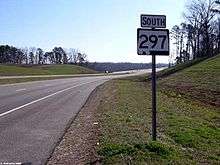Alabama State Route 297
| ||||
|---|---|---|---|---|
| Route information | ||||
| Maintained by ALDOT | ||||
| Length: | 1.05 mi[1] (1.69 km) | |||
| Proposed route | ||||
| South end: |
| |||
| Major junctions: | ||||
| North end: |
| |||
| Opened segment | ||||
| South end: | Jack Warner Parkway | |||
| North end: | Rice Mine Road | |||
| Location | ||||
| Counties: | Tuscaloosa | |||
| Highway system | ||||
| ||||
The Warrior Loop or the Tuscaloosa Eastern Bypass is a proposed four-lane, 18-mile (29 km), $250 million bypass of the city of Tuscaloosa, Alabama to be completed by 2012. Its route would begin at Interstates 20/59 in Cottondale and terminate at U.S. Highway 82 just to the west of Northport. Currently listed as State Route 297, it is estimated to serve 37,530 vehicles on a daily basis upon its completion.
Currently SR-297 is just over 1 mile (1.6 km) long serving as the fourth Black Warrior River crossing in Tuscaloosa. Its southern terminus at Jack Warner Parkway contains an elevated stub where the road will continue in its southernly track in the future. Its northern terminus is located at its intersection with Rice Mine Road.
History

By the late 1980s, it became clear that an additional vehicular crossing of the Black Warrior River would be necessary as both the U.S. Highway 43 and U.S. Highway 82 were approaching their designed carrying capacity. As a result, in 1991, the Metropolitan Planning Agency of West Alabama working with the Alabama Department of Transportation began a study of a bypass around the city.[2] By 1992, Senator Richard Shelby and Alabama congressman Claude Harris were successful in securing $6.4 million in federal funds for engineering studies, land acquisition, and construction of the bypass through the Land Surface Transportation Act.[2]
By 1997, $118,590,000, was requested to construct the first portion of the road between Interstates 20/59 in Cottondale and Rice Mine Road including a new Black Warrior River crossing.
In 2000, construction commenced on the Paul Bryant Bridge, located approximately one half of a mile to the east of the U.S. Highway 82 crossing. It opened on April 23, 2004 at a final cost of $35 million.[3] Considered to be Phase I, with the bridge completion, Phase II commenced with the appraising of properties along the proposed right-of-way between Interstate 20/59 and Rice Mine Road.[3]
Controversy
The primary opponents to the project are a group of environmentalists dedicated to the preservation of Tuscaloosa’s Hurricane Creek. The Friends of Hurricane Creek seek to alter the proposed routing to minimize degradation of the creek resulting from its construction. One of their proposals called for the rerouting of the road along Jack Warner Parkway to connect with Interstate 359 south of downtown Tuscaloosa.[4]
By 2002, the Tuscaloosa chapters of the Sierra Club and the Alabama River Alliance also joined in the chorus of groups against the construction of the bypass.[5]
See also
References
- ↑ "Milepost Maps". Alabama Department of Transportation. Retrieved 2013-10-26.
- 1 2 ISTEA. "ISTEA Reauthorization: Member Policy Initiatives and Requests for Highway & Transit Projects in the ISTEA Reauthorization". Archived from the original on 30 November 2006. Retrieved 2006-12-06.
- 1 2 Parrott, Scott (2004-04-24). "Paul Bryant Bridge open to traffic today". The Tuscaloosa News.
- ↑ Parrott, Scott (2001-03-21). "Environmentalists debate bypass location". The Tuscaloosa News.
- ↑ Beyerle, Dana (2006-12-17). "Changes in bypass route requested". The Tuscaloosa News.
